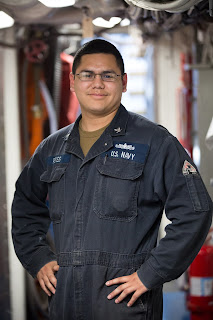Navy Office of Community Outreach
SASEBO, Japan – An El Paso, Texas, native and 2015 Socorro High School graduate is serving in Japan in the U.S. Navy aboard one of the forward-deployed mine countermeasures ship, USS Pioneer.
SASEBO, Japan – An El Paso, Texas, native and 2015 Socorro High School graduate is serving in Japan in the U.S. Navy aboard one of the forward-deployed mine countermeasures ship, USS Pioneer.
Petty Officer 3rd Class Emilio Reyes is a mineman aboard the Avenger-class mine countermeasures ship, operating out of Sasebo, Japan. The ship routinely deploys to protect alliances, enhance partnerships, and be ready to respond if a natural disaster occurs in the region.
A Navy mineman is responsible for performing their duties at sea aboard minesweepers assisting in the detection and neutralization of underwater mines. They are also responsible for safe storage, handling and loading of mines for transporting.
Reyes is proud to serve in the Pacific and fondly recalls memories of El Paso.
“Growing up I learned the importance of working hard from my father," said Reyes. "I always try to do everything right the first time to get everything done and I don’t stop until it’s time to go home.”
Moments like that makes it worth serving around the world ready at all times to defend America’s interests. With more than 50 percent of the world's shipping tonnage and a third of the world's crude oil passing through the region, the United States has historic and enduring interests in this part of the world. The Navy's presence in Sasebo is part of that long-standing commitment, explained Navy officials.
With a crew of more than 80, Pioneer is 224 feet long and weighs approximately 1,300 tons. Pioneer is one of the Navy’s 11 Avenger-class mine countermeasures ships that are designed to neutralize mines from vital waterways and harbors. There are four minesweeper in Sasebo as part of the forward-deployed mine countermeasures force that are on-call to respond in the event of a mine-clearing operation in the Indo-Pacific.
MCMs in Sasebo routinely operate with allies and partners to build mine countermeasures proficiency and sustain our alliances.
“It’s a great opportunity being overseas and I love being in Japan,” said Reyes. “The Navy has helped me learn responsibility and owning up to my mistakes and has helped me grow and mature as a person.”
As a member of one of the U.S. Navy’s most relied-upon assets, Reyes and other sailors know they are part of a legacy that will last beyond their lifetimes providing the Navy the nation needs.
“Serving in the Navy helps you succeed in life and gives you opportunities that the civilian sector doesn’t offer,” said Reyes.
Seventh Fleet, which is celebrating its 75th year in 2018, spans more than 124 million square kilometers, stretching from the International Date Line to the India/Pakistan border; and from the Kuril Islands in the North to the Antarctic in the South. Seventh Fleet's area of operation encompasses 36 maritime countries and 50 percent of the world’s population with between 50-70 U.S. ships and submarines, 140 aircraft, and approximately 20,000 sailors in the 7th Fleet.
A Navy mineman is responsible for performing their duties at sea aboard minesweepers assisting in the detection and neutralization of underwater mines. They are also responsible for safe storage, handling and loading of mines for transporting.
Reyes is proud to serve in the Pacific and fondly recalls memories of El Paso.
“Growing up I learned the importance of working hard from my father," said Reyes. "I always try to do everything right the first time to get everything done and I don’t stop until it’s time to go home.”
Moments like that makes it worth serving around the world ready at all times to defend America’s interests. With more than 50 percent of the world's shipping tonnage and a third of the world's crude oil passing through the region, the United States has historic and enduring interests in this part of the world. The Navy's presence in Sasebo is part of that long-standing commitment, explained Navy officials.
With a crew of more than 80, Pioneer is 224 feet long and weighs approximately 1,300 tons. Pioneer is one of the Navy’s 11 Avenger-class mine countermeasures ships that are designed to neutralize mines from vital waterways and harbors. There are four minesweeper in Sasebo as part of the forward-deployed mine countermeasures force that are on-call to respond in the event of a mine-clearing operation in the Indo-Pacific.
MCMs in Sasebo routinely operate with allies and partners to build mine countermeasures proficiency and sustain our alliances.
“It’s a great opportunity being overseas and I love being in Japan,” said Reyes. “The Navy has helped me learn responsibility and owning up to my mistakes and has helped me grow and mature as a person.”
As a member of one of the U.S. Navy’s most relied-upon assets, Reyes and other sailors know they are part of a legacy that will last beyond their lifetimes providing the Navy the nation needs.
“Serving in the Navy helps you succeed in life and gives you opportunities that the civilian sector doesn’t offer,” said Reyes.
Seventh Fleet, which is celebrating its 75th year in 2018, spans more than 124 million square kilometers, stretching from the International Date Line to the India/Pakistan border; and from the Kuril Islands in the North to the Antarctic in the South. Seventh Fleet's area of operation encompasses 36 maritime countries and 50 percent of the world’s population with between 50-70 U.S. ships and submarines, 140 aircraft, and approximately 20,000 sailors in the 7th Fleet.
